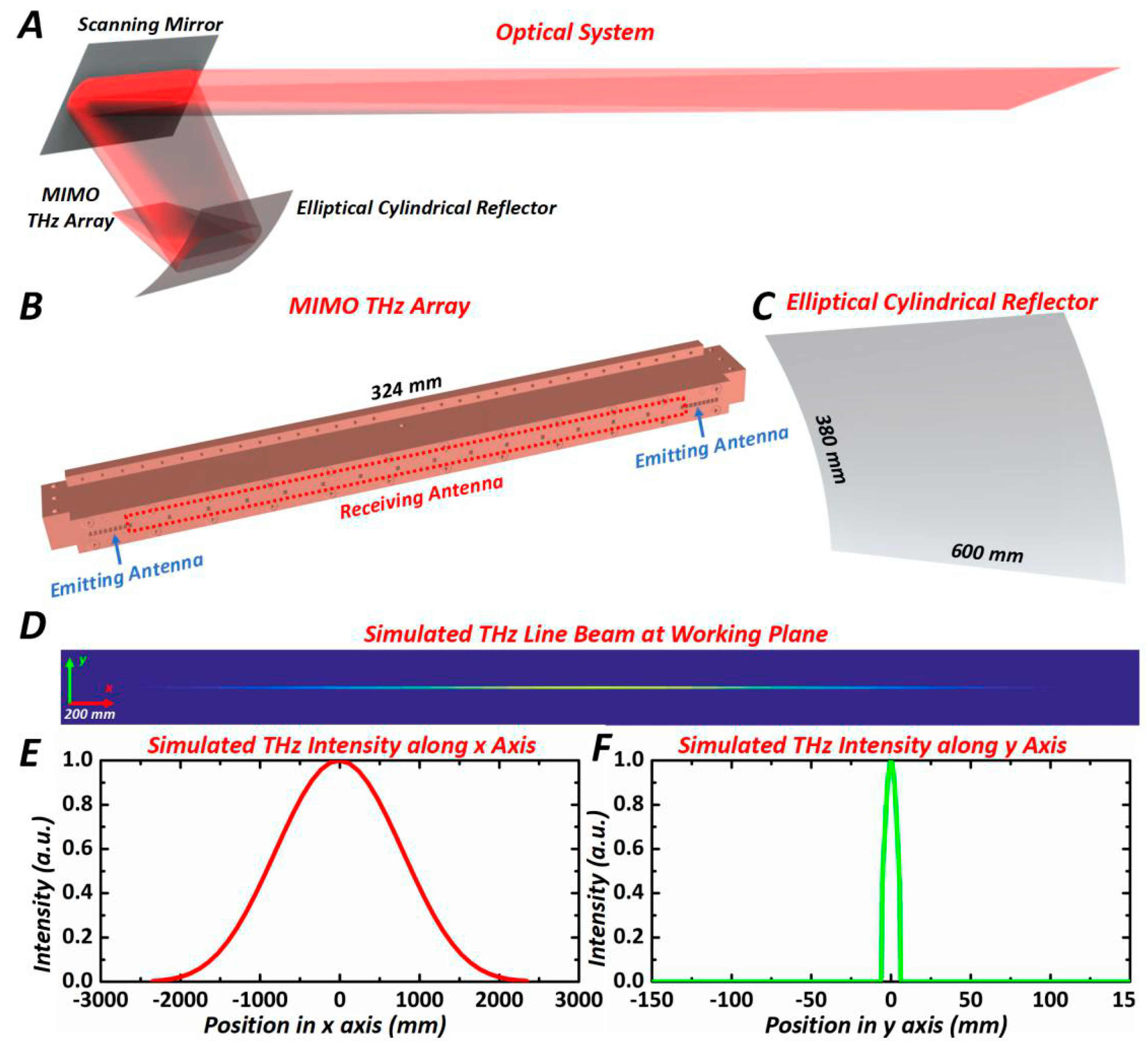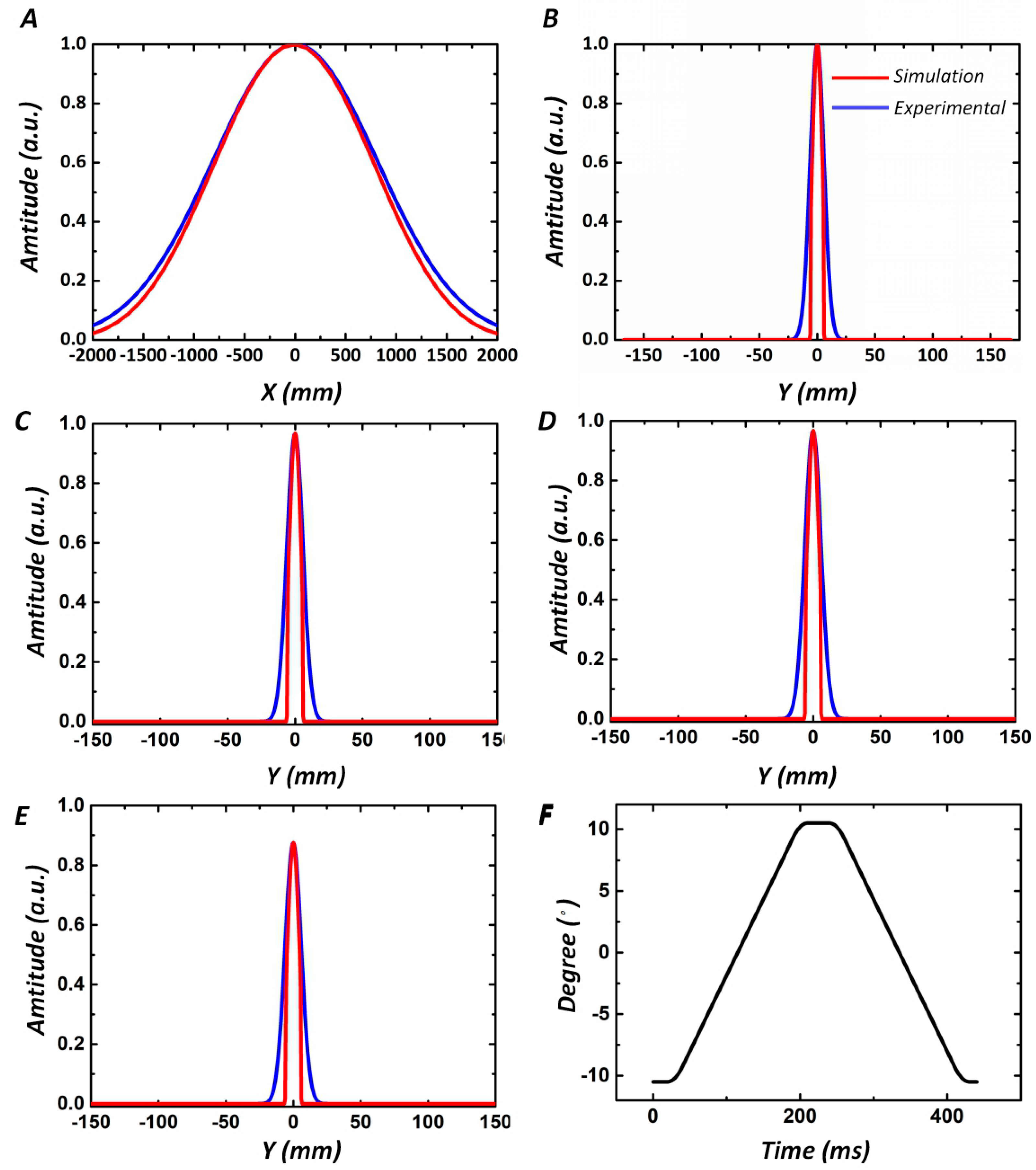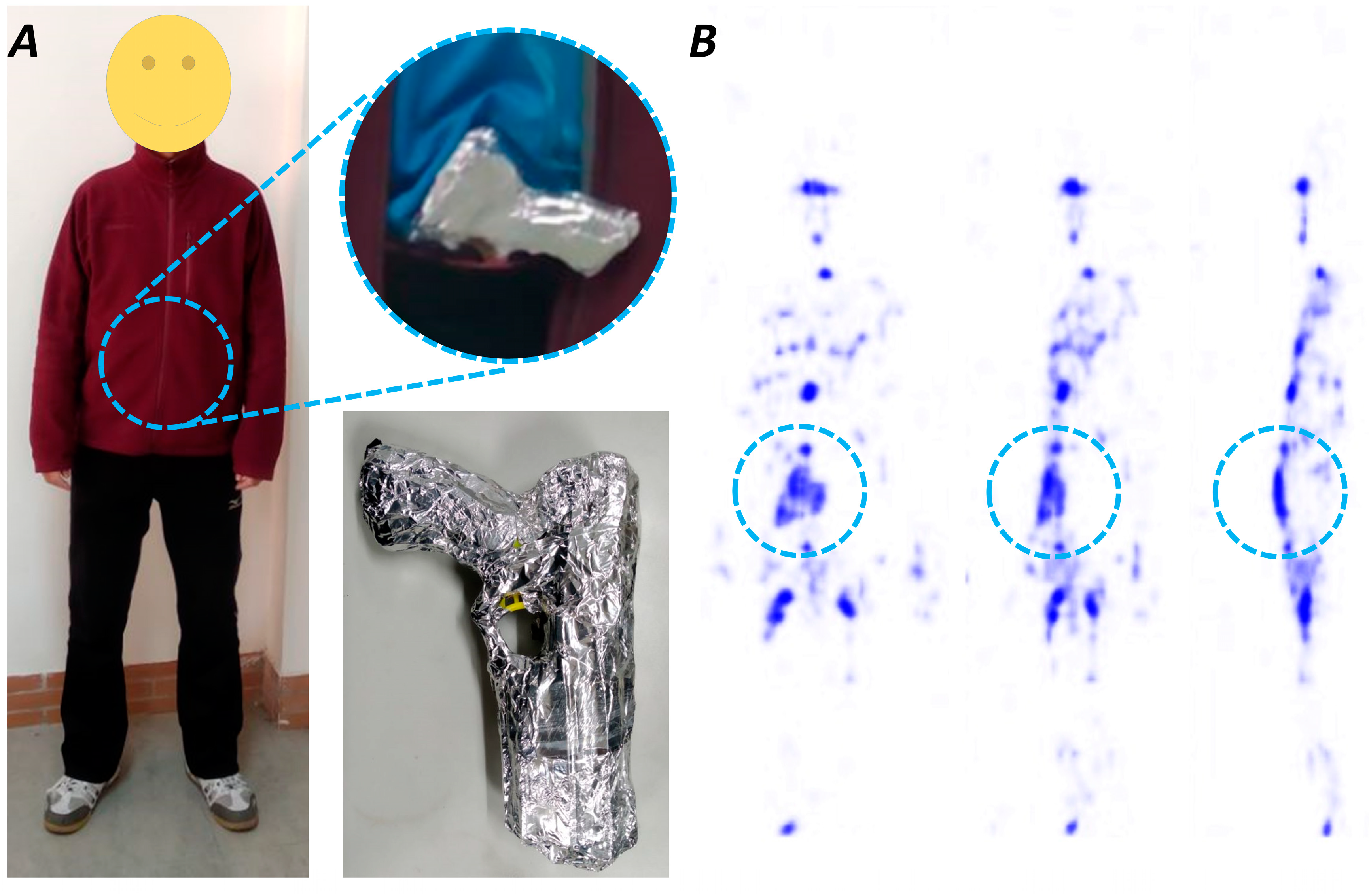Line Beam Scanning-Based Ultra-Fast THz Imaging Platform
Abstract
:Featured Application
Abstract
1. Introduction
2. Platform Design and Construction
3. Experiments
4. Conclusions
Author Contributions
Funding
Conflicts of Interest
References
- Gao, H.; Zhang, L.; Chen, Z.-Q.; Xing, Y.-X.; Xue, H.; Cheng, J.-P. Straight-Line-Trajectory-Based X-Ray Tomographic Imaging for Security Inspections: System Design, Image Reconstruction and Preliminary Results. IEEE Trans. Nucl. Sci. 2013, 60, 3955–3968. [Google Scholar] [CrossRef]
- Miller, E.A.; White, T.A.; McDonald, B.S.; Seifert, A.; Flynn, M.J. Phase contrast x-ray imaging signatures for homeland security applications. IEEE Trans. Nucl. Sci. 2013, 60, 416–422. [Google Scholar] [CrossRef]
- Michel, S.; Mendes, M.; Ruiter, J.C.; Koomen, G.C.M.; Schwaninger, A. Increasing X-ray image interpretation competency of cargo security screeners. Int. J. Ind. Ergon. 2014, 44, 551–560. [Google Scholar] [CrossRef]
- Skorupski, J.; Uchronski, P. A fuzzy model for evaluating metal detection equipment at airport security screening checkpoints. Int. J. Crit. Infrastruct. Prot. 2017, 16, 39–48. [Google Scholar] [CrossRef]
- Feng, Q. On Determining Specifications and Selections of Alternative Technologies for Airport Checked-Baggage Security Screening. Risk Anal. 2007, 27, 1299–1310. [Google Scholar] [CrossRef]
- Martin, C.A.; Lovberg, J.A.; Dean, W.H.; Ibrahim, E. High-resolution passive millimeter-wave security screening using few amplifiers. In Proceedings of the Passive Millimeter-Wave Imaging Technology X, Orlando, FL, USA, 11 April 2007. [Google Scholar]
- Zentai, G. X-ray imaging for homeland security. In Proceedings of the IEEE International Workshop on Imaging Systems & Techniques, Chania, Greece, 10–12 September 2008. [Google Scholar]
- Miller, E.A.; White, T.A.; McDonald, B.S.; Seifert, A.; Flynn, M.J. Phase contrast x-ray imaging signatures for homeland security applications. In Proceedings of the IEEE Nuclear Science Symposuim & Medical Imaging Conference, Knoxville, TN, USA, 30 October–6 November 2010; pp. 896–899. [Google Scholar]
- Clayton, J.; Shedlock, D.; Langeveld, W.G.J.; Bharadwaj, V.; Nosochkov, Y. Proposed New Accelerator Design for Homeland Security X-Ray Applications. Phys. Procedia 2015, 66, 249–259. [Google Scholar] [CrossRef] [Green Version]
- Federici, J.F.; Schulkin, B.; Huang, F.; Gary, D.; Barat, R.; Oliveira, F.; Zimdars, D. THz imaging and sensing for security applications—explosives, weapons and drugs. Semicond. Sci. Technol. 2005, 20, 266–280. [Google Scholar] [CrossRef]
- Song, Q.; Zhao, Y.; Redo-Sanchez, A.; Zhang, C.; Liu, X. Fast continuous terahertz wave imaging system for security. Opt. Commun. 2009, 282, 2019–2022. [Google Scholar] [CrossRef]
- Behnken, B.N.; Karunasiri, G.; Chamberlin, D.R.; Robrish, P.R.; Faist, J. Real-time imaging using a 2.8 THz quantum cascade laser and uncooled infrared microbolometer camera. Opt. Lett. 2008, 33, 440–442. [Google Scholar] [CrossRef]
- Chan, W.L.; Deibel, J.; Mittleman, D.M. Imaging with terahertz radiation. Rep. Prog. Phys. 2007, 70, 1325–1379. [Google Scholar] [CrossRef]
- Sunaguchi, N.; Sasaki, Y.; Maikusa, N.; Kawai, M.; Yuasa, T.; Otani, C. Depth-resolving THz imaging with tomosynthesis. Opt. Express 2009, 17, 9558. [Google Scholar] [CrossRef] [PubMed]
- Kleineostmann, T.; Knobloch, P.; Koch, M.; Hoffmann, S.; Breede, M.; Hofmann, M.; Hein, G.; Pierz, K.; Sperling, M.; Donhuijsen, K. Continuous Wave THz-imaging. Electron. Lett. 2002, 37, 1461–1463. [Google Scholar] [CrossRef]
- Jin, C.; Cheng, B.; Li, Z.; Zhang, D.; Li, M.; Zhang, Z. Two dimensional metallic photonic crystal in the THz range. Opt. Commun. 1999, 166, 9–13. [Google Scholar] [CrossRef]
- Sheen, D.M.; Mcmakin, D.L.; Hall, T.E. Three-dimensional millimeter-wave imaging for concealed weapon detection. IEEE Trans. Microw. Theory Tech. 2001, 49, 1581–1592. [Google Scholar] [CrossRef]
- Razegh, M. Toward realizing high power semiconductor terahertz laser sources at room temperature. In Proceedings of the Terahertz Physics, Devices, and Systems V: Advance Applications in Industry and Defense, Orlando, FL, USA, 25 April 2011. [Google Scholar]
- Hintzsche, H.; Jastrow, C.; Heinen, B.; Baaske, K.; Kleine-Ostmann, T.; Schwerdtfeger, M.; Shakfa, M.K.; Karst, U.; Koch, M.; Schrader, T.; et al. Terahertz Radiation at 0.380 THz and 2.520 THz Does Not Lead to DNA Damage in Skin Cells In Vitro. Radiat. Res. 2013, 179, 38–45. [Google Scholar] [CrossRef] [PubMed]
- Nishizawa, J.; Sasaki, T.; Suto, K.; Tetsuya, Y.; Tadao, T.; Takenori, T.; Takashi, S.; Yasuhiro, M. THz imaging of nucleobases and cancerous tissue using a GaP THz-wave generator. Opt. Commun. 2005, 244, 469–474. [Google Scholar] [CrossRef]
- Siebert, K.J.; Loffler, T.; Quast, H.; Mark, T.; Tobias, B.; Rainer, L.; Stephanie, C.; Hartmut, G.R. All-optoelectronic continuous wave THz imaging for biomedical applications. Phys. Med. Biol. 2002, 47, 3743–3748. [Google Scholar] [CrossRef]
- Knobloch, P.; Schildknecht, C.; Kleineostmann, T.; Koch, M.; Hoffmann, S.; Hofmann, M.; Rehberg, E.; Sperling, M.; Donhuijsen, K.; Hein, G.; et al. Medical THz imaging: An investigation of histo-pathological samples. Phys. Med. Biol. 2002, 47, 3875–3884. [Google Scholar] [CrossRef]
- Berry, C.W.; Wang, N.; Hashemi, M.R.; Unlu, M.; Jarrahi, M. Significant performance enhancement in photoconductive terahertz optoelectronics by incorporating plasmonic contact electrodes. Nat. Commun. 2013, 4, 1622. [Google Scholar] [CrossRef] [Green Version]
- Yang, S.H.; Hashemi, M.R.; Berry, C.W.; Jarrahi, M. 7.5% Optical-to-Terahertz Conversion Efficiency Offered by Photoconductive Emitters With Three-Dimensional Plasmonic Contact Electrodes. IEEE Trans. Terahertz Sci. Technol. 2014, 4, 575–581. [Google Scholar] [CrossRef]
- Zangeneh-Nejad, F.; Safian, R. Significant enhancement in the efficiency of photoconductive antennas using a hybrid graphene molybdenum disulphide structure. J. Nanophotonics 2016, 10, 036005. [Google Scholar] [CrossRef]
- Ding, J.; Kahl, M.; Loffeld, O.; Bolivar, P.H. THz 3-D Image Formation Using SAR Techniques: Simulation, Processing and Experimental Results. IEEE Trans. Terahertz Sci. Technol. 2013, 3, 606–616. [Google Scholar] [CrossRef]
- Zhang, Y.; Sun, J.; Lei, P.; Wang, H. High-frequency vibration compensation of helicopter-borne THz-SAR. IEEE Trans. Aerosp. Electron. Syst. 2016, 52, 1460–1466. [Google Scholar] [CrossRef]
- Herschel, R.; Lang, S.A.; Pohl, N. MIMO imaging for next generation passenger security systems. In Proceedings of the 11th European Conference on Synthetic Aperture Radar, Hamburg, Germany, 6 June 2016; VDE: Berlin, Germany, 2016; pp. 87–90. [Google Scholar]
- Alexander, N.E.; Alderman, B.; Allona, F.; Frijlink, P.; Gonzalo, R.; Hägelen, M.; Ibáñez, A.; Krozer, V.; Langford, M.L.; Limiti, E.; et al. TeraSCREEN: Multi-frequency multi-mode Terahertz screening for border checks. In Proceedings of the Conference on Passive and Active Millimeter-Wave Imaging XVII, Baltimore, MD, USA, 8 May 2014; SPIE: Washington, DC, USA, 2014. [Google Scholar]
- Reck, T.; Siles, J.; Jung, C.; Gill, J.; Lee, C.; Chattopadhyay, G.; Mehdi, I.; Cooper, K. Array technology for terahertz imaging. In Proceedings of the Conference on Passive and Active Millimeter-Wave Imaging XV, Baltimore, MD, USA, 26 April 2012. [Google Scholar]
- Reck, T.; Jung-Kubiak, C.; Siles, J.V.; Lee, C.; Lin, R.; Chattopadhyay, G.; Mehdi, I.; Cooper, K. A Silicon Micromachined Eight-Pixel Transceiver Array for Submillimeter-Wave Radar. IEEE Trans. Terahertz Sci. Technol. 2015, 5, 197–206. [Google Scholar] [CrossRef]
- Priebe, S.; Kannicht, M.; Jacob, M. Ultra Broadband Indoor Channel Measurements and Calibrated Ray Tracing Propagation Modeling at THz Frequencies. J. Commun. Netw. 2013, 15, 547–558. [Google Scholar] [CrossRef]
- Brook, A.; Cristofani, E.; Vandewal, M. A 3D THz Image Processing Methodology for a fully Integrated, Semi-Automatic and near Real-Time Operational System. In Proceedings of the SPIE Defense, Security & Sensing Symposium, Terahertz Physics, Devices, and Systems VI: Advanced Applications in Industry and Defense, Baltimore, MD, USA, 23–27 April 2012. [Google Scholar]
- Diamond, G. A low cost alternative to terahertz imaging for security and defense applications. SPIE Newsroom 2008. [Google Scholar] [CrossRef]
- Sheen, D.M.; Hall, T.E.; Severtsen, R.H.; McMakin, D.L.; Hatchell, B.K.; Valdez, P.L.J. Active wideband 350GHz imaging system for concealed-weapon detection. In Proceedings of the Passive Millimeter-Wave Imaging Technology XII, Orlando, FL, USA, 19 May 2009. [Google Scholar]
- Sheen, D.M.; Bernacki, B.; McMakin, D. Advanced Millimeter-Wave Imaging Enhances Security Screening. Spie Newsroom 2012. [Google Scholar] [CrossRef]
- Cooper, K.B.; Dengler, R.J.; Llombart, N.; Thomas, B.; Chattopadhyay, G.; Siegel, P.H. THz Imaging Radar for Standoff Personnel Screening. IEEE Trans. Terahertz Sci. Technol. 2011, 1, 169–182. [Google Scholar] [CrossRef]
- Cooper, K.B.; Dengler, R.J.; Llombart, N.; Bryllert, T.; Chattopadhyay, G.; Mehdi, I.; Siegel, P.H. An Approach for Sub-Second Imaging of Concealed Objects Using Terahertz (THz) Radar. J. Infraredmillimeter Terahertz Waves 2009, 30, 1297–1307. [Google Scholar] [CrossRef]




© 2019 by the authors. Licensee MDPI, Basel, Switzerland. This article is an open access article distributed under the terms and conditions of the Creative Commons Attribution (CC BY) license (http://creativecommons.org/licenses/by/4.0/).
Share and Cite
Huang, H.; Liu, Q.; Zou, Y.; Zhu, L.; Li, Z.; Li, Z. Line Beam Scanning-Based Ultra-Fast THz Imaging Platform. Appl. Sci. 2019, 9, 184. https://doi.org/10.3390/app9010184
Huang H, Liu Q, Zou Y, Zhu L, Li Z, Li Z. Line Beam Scanning-Based Ultra-Fast THz Imaging Platform. Applied Sciences. 2019; 9(1):184. https://doi.org/10.3390/app9010184
Chicago/Turabian StyleHuang, Huachuan, Qiao Liu, Yi Zou, Liguo Zhu, Zhenhua Li, and Zeren Li. 2019. "Line Beam Scanning-Based Ultra-Fast THz Imaging Platform" Applied Sciences 9, no. 1: 184. https://doi.org/10.3390/app9010184
APA StyleHuang, H., Liu, Q., Zou, Y., Zhu, L., Li, Z., & Li, Z. (2019). Line Beam Scanning-Based Ultra-Fast THz Imaging Platform. Applied Sciences, 9(1), 184. https://doi.org/10.3390/app9010184




